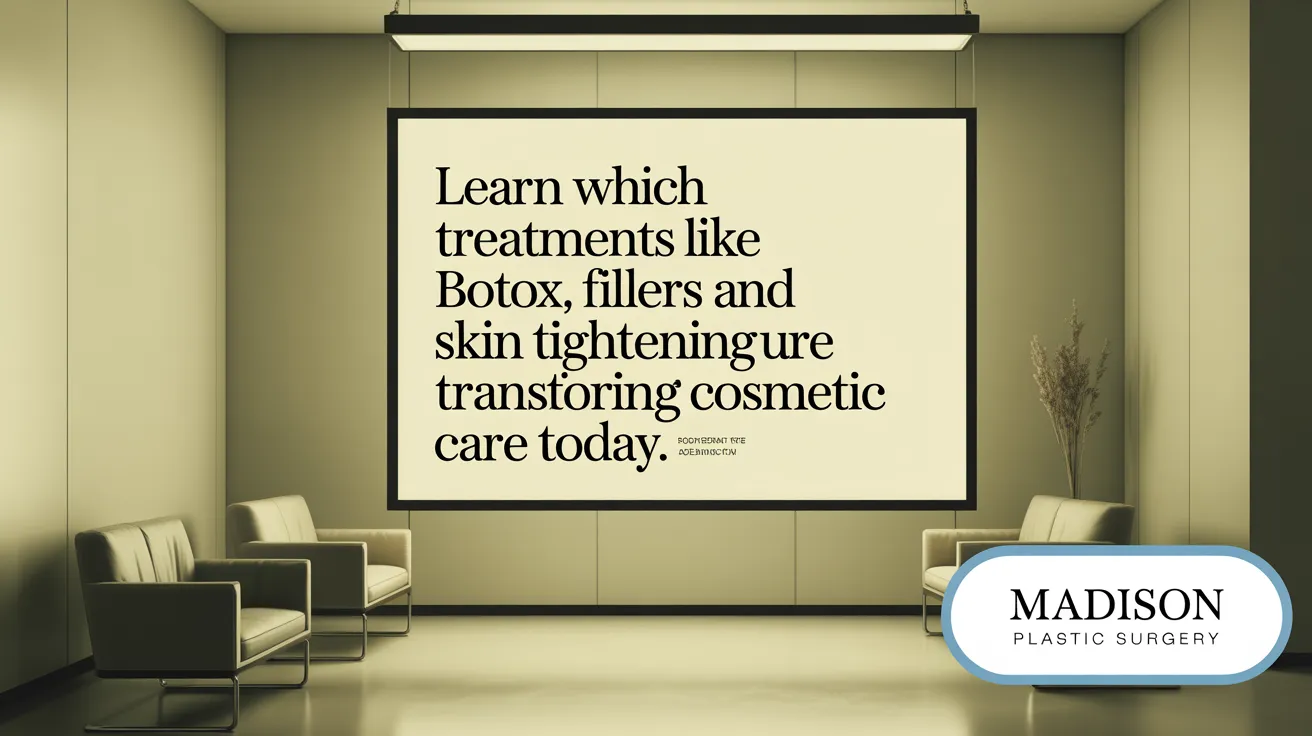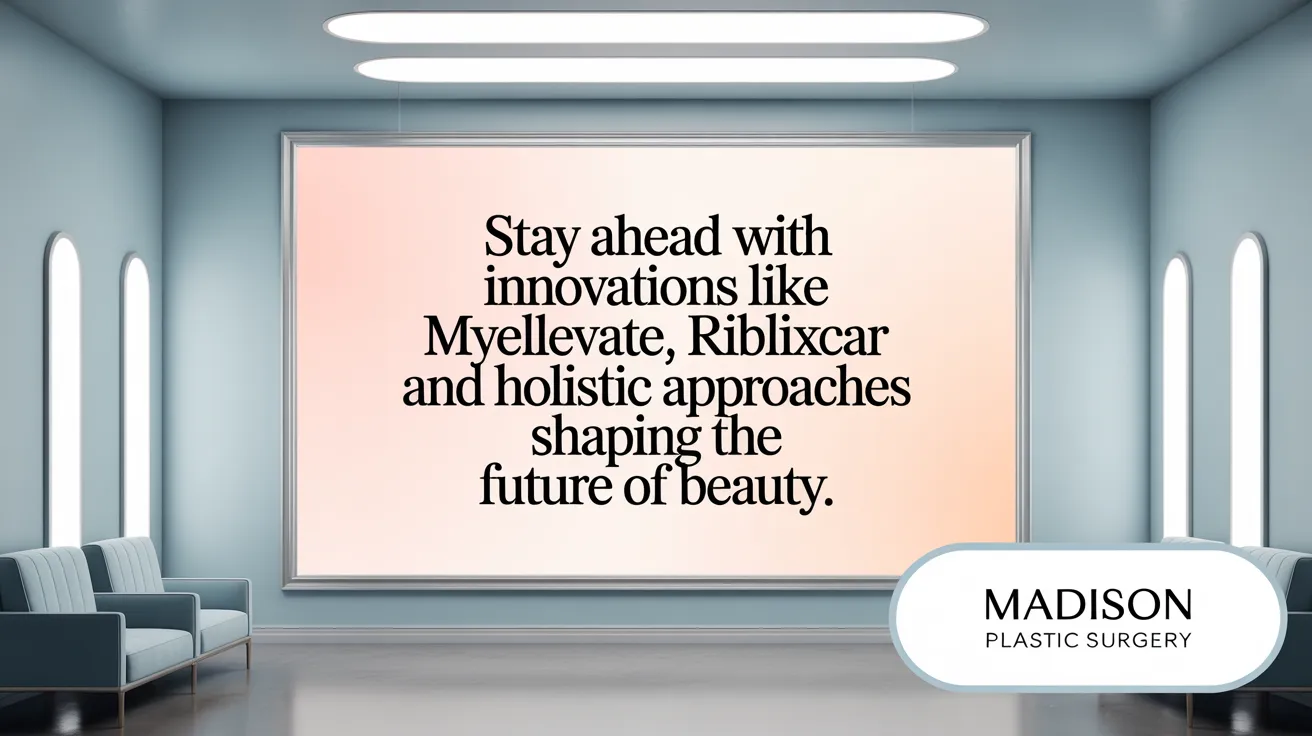Introduction to the Rise of Minimally Invasive Cosmetic Procedures
Defining Minimally Invasive Cosmetic Procedures
Minimally invasive cosmetic procedures utilize advanced techniques such as injectables, laser therapies, and radiofrequency treatments that require minimal incisions or no surgery at all. These interventions offer a gentle alternative to traditional surgical approaches, focusing on subtle, natural enhancements that restore confidence without the typical burdens of invasive surgery.
Increasing Patient Demand and Prevailing Trends
The popularity of these procedures is rising steadily, fueled by a growing patient preference for options with shorter recovery times and less visible scarring. Trends indicate an expanding demographic, including younger adults pursuing early intervention 'prejuvenation' and a 7% annual growth in procedures like neuromodulator injections and hyaluronic acid fillers. Innovations in AI-assisted planning and personalized treatments continue to propel patient interest.
Advantages Over Traditional Surgery
Compared to conventional cosmetic surgery, minimally invasive options offer distinct benefits: reduced pain, diminished risk of complications, minimal downtime, and the preservation of natural aesthetics. These features not only enhance patient comfort but also make aesthetic enhancements more accessible to those seeking effective yet less disruptive solutions to their cosmetic concerns.
Cutting-Edge Technologies Driving Minimally Invasive Cosmetic Innovations

What technological advancements are enhancing minimally invasive cosmetic procedures?
The field of minimally invasive cosmetic procedures has seen remarkable technological progress that elevates both safety and outcomes. Advancements in laser and radiofrequency technologies now provide highly effective solutions for skin tightening, texture improvement, and wrinkle reduction. Procedures such as radiofrequency microneedling benefits stimulate collagen production, enhancing skin laxity and rejuvenation with minimal downtime.
Artificial intelligence in aesthetic procedures is playing an increasingly influential role by assisting plastic surgeons in aesthetic treatment planning. AI-driven facial mapping offers precise, data-driven analyses enabling personalized and natural-looking enhancements. This technology reduces variability and supports optimal dosing of neuromodulators and hyaluronic acid fillers for subtle, tailored results.
Moreover, regenerative medicine is integrated into these innovations with techniques like platelet-rich plasma (PRP), nanofat injections, and adipose-derived stem cells. These methods harness the body's own healing factors to catalyze collagen synthesis and tissue regeneration. They promote vibrant, youthful skin improvements that complement traditional injectables and laser therapies.
The convergence of skin booster treatments, intelligent planning tools, and biologic therapies represents a new era in minimally invasive aesthetics—offering patients sophisticated, customized care with accelerated recovery and enduring, natural results.
Popular Minimally Invasive Cosmetic Treatments and Their Applications

What are the most popular minimally invasive cosmetic procedures currently?
Neuromodulator injections like Botox® and its advanced techniques remain the gold standard for reducing wrinkles. These treatments work by relaxing facial muscles, smoothing out crow's feet, frown lines, and forehead wrinkles with effects lasting several months. Innovative forms such as Micro-Botox and Baby Botox offer subtle yet natural enhancements, while specialized applications target jawline slimming, lip flips, and even conditions like excessive sweating.
Hyaluronic acid fillers are extensively used to restore facial volume and enhance contours instantly. Popular formulations include Juvederm® and Restylane® products, with longer-lasting collagen-stimulating fillers such as Sculptra® providing gradual, natural improvements. These fillers help address fine lines, hollow areas, and overall facial rejuvenation.
Radiofrequency microneedling benefits has surged as a versatile method to improve skin texture and reduce laxity across multiple areas including the face, neck, and body. By combining microneedling with radiofrequency energy, it stimulates collagen production deeply, tightening skin and smoothing wrinkles with minimal downtime. When paired with technologies like FaceTite®, it offers remarkable skin firming results.
Non-surgical body contouring options such as cryolipolysis (fat freezing) and laser skin tightening are increasingly favored for reducing stubborn fat and tightening skin without surgery. These procedures minimize recovery time while sculpting areas like the abdomen, arms, and thighs to create athletic, natural-looking physiques.
Injectable fat-dissolving treatments like Kybella® target localized fat deposits, especially under the chin, delivering permanent reduction through a series of minimally invasive sessions. Additionally, skin booster treatments combining neuromodulators and hyaluronic acid fillers infuse hydration and revitalization, enhancing skin health and appearance subtly and effectively.
These advantages of minimally invasive treatments offer patients attractive alternatives to surgery, balancing safety, convenience, and natural aesthetics, perfectly aligning with modern trends toward personalized, low-downtime cosmetic enhancements.
Emerging Trends in Minimally Invasive Facial Rejuvenation and Body Sculpting

Which new and emerging treatments are shaping facial rejuvenation and body sculpting?
Minimally invasive facial and body enhancement procedures are increasingly favored for their natural results and reduced recovery times. Among the forefront innovations is MyEllevate, a subtle suture-based technique that redefines the jawline and neck. It offers a natural, refined contour without the invasiveness or downtime of traditional surgery.
Another notable advancement is FaceTite, which utilizes radiofrequency microneedling benefits to simultaneously tighten skin and melt fat in the face and neck areas. This approach delivers effective skin rejuvenation with minimal downtime.
For body contouring, scarless waist reshaping procedures like RibXcar are gaining attention. This technique remodels the floating ribs internally, achieving waist circumference reductions of 6 to 11 centimeters without external scars or traditional incisions.
Fat transfer breast augmentation techniques are also prominent, offering dual benefits by harvesting fat from donor sites to naturally restore volume and contours on the face or breasts. This method enhances softness and authenticity in aesthetic rejuvenation compared to synthetic fillers.
Alongside these treatments, the growing trend of prejuvenation reflects a shift towards early, preventative aesthetic care. Utilizing gentle neurotoxin micro-dosing, microneedling, and laser resurfacing, patients aim to delay visible aging with minimal intervention.
Importantly, holistic wellness is now integrated within aesthetic approaches; hormone balancing, nutritional counseling, and regenerative therapies such as platelet-rich plasma (PRP) complement cosmetic procedures to optimize overall skin health and patient vitality.
These innovations collectively respond to the sophisticated patient desire for subtle, personalized enhancements that maintain natural expressions and support long-term confidence with minimal disruption to lifestyle.
Patient Considerations, Safety, and Treatment Planning

What should patients consider when choosing minimally invasive cosmetic procedures?
Consultation with board-certified plastic surgeons is the cornerstone of successful treatment planning. Surgeons evaluate your facial anatomy, skin quality, and aesthetic goals to tailor a personalized approach. This professional guidance ensures safety and realistic expectations.
Many minimally invasive procedures, including neuromodulator injections and hyaluronic acid fillers, offer temporary benefits requiring maintenance of minimally invasive procedures sessions. It's important for patients to appreciate that multiple sessions for treatment outcomes or combination therapies—like radiofrequency microneedling benefits paired with laser resurfacing or skin booster treatments—often provide the most natural, effective outcomes.
While advantages of minimally invasive treatments include reduced downtime, less scarring, and quicker recovery, they may not match the durability or transformative potential of surgical options vs minimally invasive methods. For certain aesthetic concerns, such as significant skin laxity or volume loss, surgery remains the preferred solution to achieve lasting results.
Balancing benefits and risks involves understanding that minimally invasive procedures tend to improve appearance subtly and gradually. Patients should discuss with their surgeon any potential risks, treatment longevity, and the maintenance of minimally invasive procedures commitment necessary to sustain results.
This collaborative planning promotes a sophisticated enhancement journey, blending advancements in laser and radiofrequency technologies with expert surgical mastery to restore confidence with natural, personalized outcomes.
The Growing Market and Future Outlook for Minimally Invasive Cosmetic Procedures

What does the market data reveal about the growth and future of minimally invasive cosmetic procedures?
Minimally invasive cosmetic procedures have demonstrated robust growth, expanding by 7% in 2023 and surpassing surgical interventions in popularity. This increasing demand reflects evolving patient preferences toward treatments offering effective results with minimal downtime and natural aesthetic outcomes. Younger demographics, particularly those aged 20 to 39, are adopting these procedures as part of early preventative care or “prejuvenation,” contributing to significant growth in this segment. Male patients have similarly increased their participation, underscoring a broadening appeal across genders.
Market drivers include cutting-edge technological advancements such as AI-assisted treatment planning and improved injectable formulations, which enhance precision and customize treatments for individual anatomy and goals. Combination therapies integrating neuromodulators, dermal fillers, PRP, and radiofrequency microneedling benefits offer holistic rejuvenation with subtle, long-lasting effects. Furthermore, emerging devices and techniques continue to raise the safety profile and accessibility of these procedures.
Looking ahead, the minimally invasive cosmetic market is poised for sustained expansion. Innovations in bio-stimulatory injectables, energy-based devices, and AI-driven diagnostics will likely refine treatment efficacy and patient satisfaction. As the aesthetic medicine field embraces personalized, natural-looking enhancements alongside scientific rigor, demand is expected to keep growing. This trajectory promises enhanced patient experiences through sophisticated, less intrusive options that preserve individuality and confidence with reduced recovery times.
Minimally Invasive Surgery in Cosmetic and Broader Medical Contexts
What is Minimally Invasive Surgery (MIS) and What Are Its Advantages?
Minimally invasive surgery (MIS) encompasses surgical techniques that use smaller incisions compared to traditional open surgery. These procedures employ specialized instruments, cameras, and sometimes robotic assistance to perform complex surgeries with precision.
The main benefits of MIS are reduced pain, shorter hospital stays, quicker recovery times, minimal scarring, and a decreased risk of infection and complications. These advantages of minimally invasive procedures have made MIS the preferred choice in various medical fields, including gynecology, cardiology, and general surgery.
How Do Robotic-Assisted and Laparoscopic Procedures Impact Surgical Practice?
Robotic-assisted surgery has gained significant traction alongside laparoscopic surgery. It enhances surgical precision through improved 3D visualization, wristed instruments, and better ergonomics. Robotics is increasingly used in procedures such as prostatectomy and hernia repair, often providing a shorter learning curve for surgeons.
Laparoscopy remains a cornerstone of MIS, with substantial increases in procedures like cholecystectomy and appendectomy. However, as robotic surgery expands, it is gradually overtaking laparoscopy in certain specialties due to its advantages. For more detail, see Minimally Invasive Surgery (MIS) Evolution, Robotic-Assisted Surgery, and Technological Advances and Laparoscopy as Standard Procedure and Increased Surgical Training.
How Does Cosmetic MIS Intersect With Broader Surgical Advances?
In the cosmetic arena, minimally invasive procedures harness advanced technologies like radiofrequency energy, laser resurfacing, and injectable neuromodulators and fillers. Techniques such as radiofrequency microneedling benefits and FaceTite mirror the principles of MIS by minimizing downtime and reducing tissue trauma.
The adoption of advanced imaging and AI-assisted treatment planning in cosmetic procedures reflects the influence of medical surgery innovations. These developments ensure personalized, natural-looking results with enhanced safety. For deeper insight into these cosmetic advances, refer to Minimally Invasive Facial Cosmetic Procedures, 2024 Trends in Plastic Surgery and Aesthetics, and AI in aesthetic procedures and improved injectable treatments.
Why Is Maintaining Surgical Skills Beyond MIS Essential?
Despite the rise of MIS and robotic techniques, open surgery skills remain indispensable. Complex or unforeseen cases may necessitate conversion to open surgery to safeguard patient outcomes.
Surgical training programs emphasize exposure to both minimally invasive and open procedures to maintain a comprehensive skill set. Understanding anatomy through open surgery continues to underpin surgical competence. For more information, see Limitations of MIS and Role of Open Surgery and Concerns Over Open Surgery Training.
How does minimally invasive surgery in cosmetic procedures relate to broader MIS trends in medicine?
Minimally invasive surgery broadly entails smaller incisions and advanced technologies like laparoscopy and robotics, leading to faster recovery and fewer complications. Cosmetic MIS benefits from similar innovations including radiofrequency and laser devices. Robotic-assisted surgery is increasingly prevalent in medical disciplines, enhancing precision, which may influence cosmetic surgery technology. Despite these advances, proficiency in open surgery remains critical due to complex cases where MIS is unsuitable. Explore Minimally Invasive Surgery Market Trends and Technological Advancements and Future Advancements in Minimally Invasive Procedures for comprehensive context.
Looking Ahead: The Future Landscape of Minimally Invasive Cosmetic Procedures
Ongoing Innovation and Patient-Centered Care
Minimally invasive cosmetic procedures continue to evolve rapidly, driven by advances in laser, radiofrequency, and injectable technologies. Emphasis remains on enhancing patient comfort with reduced downtime and subtle, natural-looking results. Treatments such as radiofrequency microneedling and innovative skin boosters combine efficacy with minimal invasiveness, tailored uniquely to each patient's anatomy and aesthetic goals.
Balance Between Non-Surgical and Surgical Options
While non-surgical procedures offer convenience and quick recovery, certain aesthetic goals still require surgical intervention for lasting results. Expert consultation with board-certified surgeons ensures personalized treatment planning, setting realistic expectations and optimizing outcomes. Hybrid approaches integrating both modalities provide versatile solutions to meet diverse patient needs.
Embracing Technology for Natural, Elegant Outcomes
The incorporation of artificial intelligence and 3D imaging enables precise treatment mapping, enhancing safety and predictability. Bio-stimulatory fillers and regenerative techniques like platelet-rich plasma complement technological advances, facilitating collagen production and tissue rejuvenation. This synergy underscores a future where elegant, natural enhancements prevail without compromising patient well-being.
